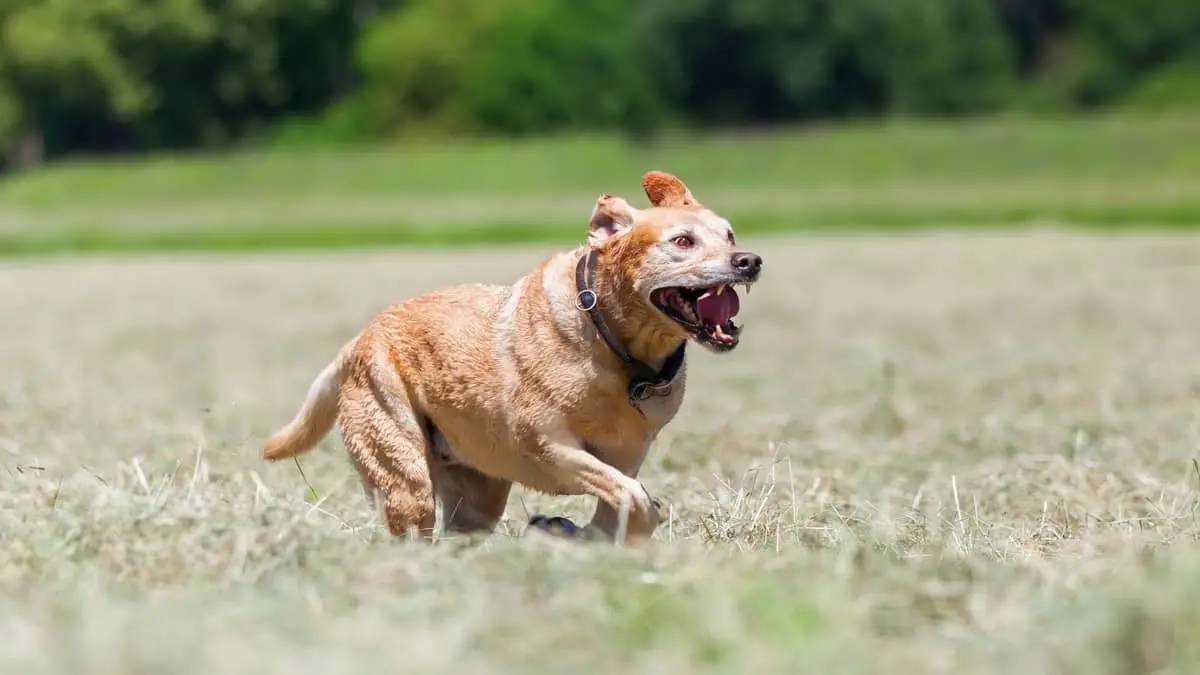Last Updated on November 11, 2023 by Linda Richard
A Labrador retriever running is a glorious sight but how fast can a lab run and do these dogs make for good running buddies? We know that labs are energetic but we also know that they are not a dedicated “running breed” such as sighthounds or huskies. Instead, Labrador retrievers are actually a swimming “water retriever” breed. So, how fast can a lab run, and is this a good breed for a jogging buddy?
Table of Contents
How Fast Can A Lab Run?
The Labrador top speed is listed by most sources as 35 miles per hour or 56 km/h. This is very respectable for a dog. It’s also quite faster than the top human sprinting speed of 28 m/h or 25 km/h. Besides, we are comparing the standard Labrador top speed with the optimal recorded human speed.
In other words, if your Labrador decides to run through an open area, you can forget about catching your dog without a vehicle.
How Fast Can A Labrador Retriever Run Over Large Distances?
The average Labrador can run non-stop for about 5 straight miles (8 km). A fit dog that has built its endurance up can easily cover 10 miles (16 km) without stopping too. This isn’t at top speed, however, but at more of a jogging speed of 14 to 18 mph (22 to 29 km/h).
Even a fit dog will need to rest and drink quite a bit of water after running for 5-10 miles without stopping, however.
How Fast Can A Lab Run As A Pup and Should You Jog With Your Puppy Lab?
It’s generally ill-advised to run over significant distances with a lab that’s still growing. The reason is similar to why you shouldn’t over-exercise a young human child – when the body is still growing and developing, prolonged and extensive exercise can be harmful. Besides, a pup’s top run speed won’t be anywhere near that of a grown lab anyway.

Read more about: When Is A Lab Full Grown and How Quickly Will Your Pup Turn Into A Dog?
Of course, young labs are very playful and you should give them plenty of active playtime. However, if you’re planning on daily 10-mile runs and you want a running buddy, wait until your lab is at least 10-months old.
How Fast Can A Lab Run When Older?
This will largely depend on the health and fitness level of the dog – these are more detrimental here than the actual age. Even a 10-year-old lab can run as fast and for as long as a 2-year-old dog if there are no health considerations.
If your dog has started developing some health issues, however, you should usually stop going on long runs with your pooch. Some exercise will still be needed but you should consult with your vet first. The exact type of health concerns you’re dealing with will determine what type of exercise your dog needs. Usually, better alternatives for older labs are just brisk walks or swimming.
Health Concerns That Can Affect How Fast Can A Lab Run
The two key conditions a grown-up lab can (and usually will) develop are Hip dysplasia and elbow dysplasia. These are very common in other breeds as well so don’t think that labs are at a disadvantage in that regard. As to what these are – quite simply they are joint pains and problems.
Both hip and elbow dysplasia are actually groups of several different conditions of the joints that tend to be bundled into the general “dysplasia” term.
Can hip or elbow dysplasia be prevented? Largely, yes. You’ll need to do these several things for your dog:
- Feed your pooch a very high-quality and nutritious food
- Be measured with how much your exercise your dog.
- Add swimming into your dog’s exercise regime
This last point is something crucial that most lab owners neglect. Remember that Labradors are a breed that has evolved and been bred to be excellent swimmers. So, while you can push your dog to run 10 miles a day, a mix of running and swimming would be much healthier for the lab’s joints.
How Fast Can A Labrador Retriever Run Compared To Other Breeds?
Labradors are pretty good runners but they are not “exceptional” compared to other breeds. This is largely because they were never bred for running, at least not as much as other breeds.
Labs Compared To Sighthounds
The top speed for a Greyhound is 45 mph or 72 km/h. For a Saluki, that’s 43 mph or 69 km/h. this is quite faster than the average Labrador which is quite normal. Sighthounds are essentially the cheetahs of the canine world while labs are more well-rounded.
Labs Compared To Huskies and Other Sled Dogs
Huskies are also a very narrowly specialized breed. These northern dogs are some of the best marathon runners in the whole animal kingdom together with horses, camels, and humans. Huskies can literally run for days without needing to eat food because of their unique metabolism. Labs can’t do that and will need to rest after several miles of runtime. They will also need quite a rich meal at the end of the day as well as lots of water.
These two comparisons aren’t exactly fair, however. Both sighthounds and sled dogs are highly specialized animals. If you are to compare Labradors to almost any other dog breed, they are very good running dogs.
Labrador Running Preparation and Training
You can’t just expect an unfit lab to start running miles at a time from Day 1. You’ll need to gradually get your lab fit. It’s a good idea to consult with a vet regarding your dog’s individual fitness level and running potential.
Usually, you’d want to start with brisk walks and quick runs in the neighborhood. Keep a close eye on your dog’s performance, fitness level, breathing, and behavior. There should never be a point where you’re pushing your lab too hard. You’re looking to raise a running buddy, not an Olympian.
With a slow and gradual improvement that’s personalized to your dog’s needs, you can get any health lab into shape in a matter of weeks or months.
Read more about: Why Are Labs Hyper?


4 thoughts on “How Fast Can A Lab Run and Do These Dogs Make For Good Running Buddies?”